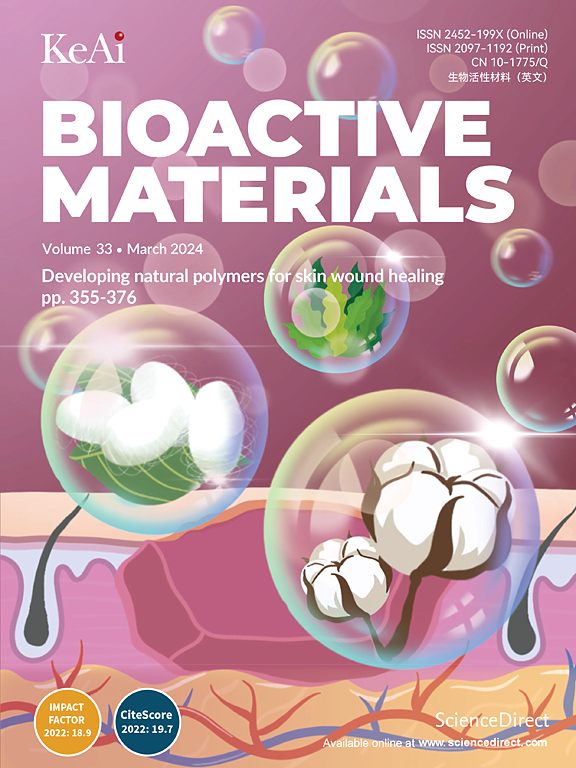The paradigm shifts of periodontal regeneration strategy: From reparative manipulation to developmental engineering
IF 18
1区 医学
Q1 ENGINEERING, BIOMEDICAL
引用次数: 0
Abstract
Ideal periodontal regeneration requires the integration of alveolar bone, periodontal ligament, and cementum, along with Sharpey's fibers for occlusal force resistance. However, physiological regeneration remains rare due to its intricate structure, making clinical regeneration a challenge. Periodontal ligament stem cells (PDLSCs), first isolated in 2004, hold the key to multi-directional differentiation into cementoblasts, fibroblasts, and osteoblasts. While traditional therapies like guided tissue regeneration (GTR) aim to activate PDLSCs, clinical outcomes are inconsistent, suggesting the need for additional strategies to enhance PDLSCs' functions. Advancements in molecular biotechnology have introduced the use of recombinant growth factors for tissue regeneration. However, maintaining their efficacy requires high doses, posing cost and safety issues. Multi-layered scaffolds combined with cell sheet technology offer new insights, but face production, ethical, and survival challenges. Immune regulation plays a crucial role in PDLSC-mediated regeneration. The concept of “coagulo-immunomodulation” has emerged, emphasizing the coupling of blood coagulation and immune responses for periodontal regeneration. Despite its potential, the clinical translation of immune-based strategies remains elusive. The “developmental engineering” approach, which mimics developmental events using embryonic-stage cells and microenvironments, shows promise. Our research group has made initial strides, indicating its potential as a viable solution for periodontal complex regeneration. However, further clinical trials and considerations are needed for successful clinical application. This review aims to summarize the strategic transitions in the development of periodontal regenerative materials and to propose prospective avenues for future development.

牙周再生策略的范式转变:从修复操作到发展工程
理想的牙周再生需要结合牙槽骨、牙周韧带和牙骨质,并配合Sharpey氏纤维抵抗咬合力。然而,由于其复杂的结构,生理再生仍然很少见,这给临床再生带来了挑战。牙周韧带干细胞(PDLSCs)于2004年首次分离,是多向分化为成骨水泥细胞、成纤维细胞和成骨细胞的关键。虽然传统疗法如引导组织再生(GTR)旨在激活PDLSCs,但临床结果不一致,这表明需要额外的策略来增强PDLSCs的功能。分子生物技术的进步引入了重组生长因子用于组织再生。然而,维持它们的功效需要高剂量,这带来了成本和安全问题。多层支架结合细胞片技术提供了新的见解,但面临生产、伦理和生存的挑战。免疫调节在pdlsc介导的再生中起着至关重要的作用。“凝血-免疫调节”的概念已经出现,强调血液凝固和免疫反应的耦合牙周再生。尽管具有潜力,但基于免疫的策略的临床转化仍然难以捉摸。利用胚胎期细胞和微环境模拟发育事件的“发育工程”方法显示出了希望。我们的研究小组已经取得了初步进展,表明它有可能成为牙周复组织再生的可行解决方案。然而,成功的临床应用还需要进一步的临床试验和考虑。本文综述了牙周再生材料发展的战略转变,并对未来的发展方向进行了展望。
本文章由计算机程序翻译,如有差异,请以英文原文为准。
求助全文
约1分钟内获得全文
求助全文
来源期刊

Bioactive Materials
Biochemistry, Genetics and Molecular Biology-Biotechnology
CiteScore
28.00
自引率
6.30%
发文量
436
审稿时长
20 days
期刊介绍:
Bioactive Materials is a peer-reviewed research publication that focuses on advancements in bioactive materials. The journal accepts research papers, reviews, and rapid communications in the field of next-generation biomaterials that interact with cells, tissues, and organs in various living organisms.
The primary goal of Bioactive Materials is to promote the science and engineering of biomaterials that exhibit adaptiveness to the biological environment. These materials are specifically designed to stimulate or direct appropriate cell and tissue responses or regulate interactions with microorganisms.
The journal covers a wide range of bioactive materials, including those that are engineered or designed in terms of their physical form (e.g. particulate, fiber), topology (e.g. porosity, surface roughness), or dimensions (ranging from macro to nano-scales). Contributions are sought from the following categories of bioactive materials:
Bioactive metals and alloys
Bioactive inorganics: ceramics, glasses, and carbon-based materials
Bioactive polymers and gels
Bioactive materials derived from natural sources
Bioactive composites
These materials find applications in human and veterinary medicine, such as implants, tissue engineering scaffolds, cell/drug/gene carriers, as well as imaging and sensing devices.
 求助内容:
求助内容: 应助结果提醒方式:
应助结果提醒方式:


